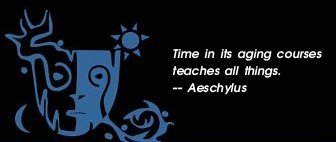|

July 2007
Find myth- and Mythic Journeys-related events on our
Annual Calendar
 July 1 — Crop Over Festival July 1 — Crop Over Festival
Barbados
This festival comes from the period of time when the sugar cane industry dominated the island. After the final harvest (crop over) when the last canes had been delivered to the mill, the slaves were given a few days off to relax and celebrate. Everyone dressed in their finest clothes, even adorning the beasts who had helped them in their labors. Music, dancing, and feasting abounded. This holiday was revived in 1974, and is now celebrated with a full month of merry-making that includes contests to determine the best sugar cane cutters and calypso dancers. The both the finest adult and child calypso couples are crowned King and Queen of the festival. Kadooment Day, the last day of the festival on August 1st, is marked by a grand costumed parade with stilt walkers, land ships, decorated carts, and the very best steel bands providing the soca and calypso music.
July 3 — Beginning of Dog Days
The 40-day period from July 3 to August 11 traditionally known as the dog days, the hottest and most unhealthy days of the year, end today. The term "Dog Days" was coined by the ancient Romans, who called these days caniculares dies (days of the dogs) after Sirius, the Dog Star, the brightest star in the heavens besides the Sun. The Dog Days originally were the days when Sirius, the Dog Star, rose just before or at the same time as sunrise, which is no longer true owing to precession of the equinoxes. The ancients sacrificed a brown dog at the beginning of the Dog Days to appease the rage of Sirius, believing that that star was the cause of the hot, sultry weather. According to Brady's Clavis Clanedarium (1813) the Dog Days were popularly believed to be an evil time "when the seas boiled, wine turned sour, dogs grew mad, and all creatures became languid, causing to man burning fevers, hysterics, and phrensies."
July 4 — Independence Day
United States of America
 This national holiday marks the signing of the Declaration of Independence from the United Kingdom of Great Britain on July 4, 1776 in Philadelphia, Pennsylvania. The original version of the document written primarily by Thomas Jefferson was signed by John Hancock, president of the Continental Congress, alone; it wasn't until August 8th that a printed version of the document we know today was actually signed by the entire Continental Congress. Even that event was concluded in secrecy in order to protect the members from British reprisals. Residents of that city who gathered together on July 8th to hear the first public reading of the document began wild celebrations in the streets. This national holiday marks the signing of the Declaration of Independence from the United Kingdom of Great Britain on July 4, 1776 in Philadelphia, Pennsylvania. The original version of the document written primarily by Thomas Jefferson was signed by John Hancock, president of the Continental Congress, alone; it wasn't until August 8th that a printed version of the document we know today was actually signed by the entire Continental Congress. Even that event was concluded in secrecy in order to protect the members from British reprisals. Residents of that city who gathered together on July 8th to hear the first public reading of the document began wild celebrations in the streets.
Legend has it that the Liberty Bell was rung until it cracked, although historians seriously doubt the story. (The crack gradually expanded until it was finally declared unringable following its last ringing on George Washington's birthday in 1846.) Word of the Declaration of Independence spread rapidly throughout the colonies, where bonfires and huge celebrations greeted the announcement. The date of the first signing has been celebrated every year since with parades, picnics, baseball games, barbeques, fireworks, and general hoopla.
 July 7 — Hoshi Matsuri (Star Festival) July 7 — Hoshi Matsuri (Star Festival)
or Tanabata Matsuri (Weaving Loom Festival)
Japan & Korea
There are several legends surrounding this celebration. One is of Orihime (the star Vega, also called the Weaving Princess), daughter of the Sky King, Tenkou.
Orihime Boshi sat every day by the banks of Amanogawa, the River of Heaven (the Milky Way). There she worked diligently weaving the most beautiful of clothes. It was a lonely life, and she sadly believed that she would never meet anyone, never fall in love, never marry. Tenkou loved his daughter, and didn't wish her to remain unhappy, so he arranged for her to meet Hiko Boshi, a young cow herder (the star Aquila) who lived and workd on the other side of the river. The couple, on first sight of each other, instantly fell in love and soon thereafter were married. Theirs was such a happy union that they no longer attended to their former duties. Orihime no longer wove beautiful garments. Hiko's cattle roamed all over heaven.
Angry with his daughter and son-in-law, Tenkou separated the lovers, banishing Hiko to his former side of the river, and forbidding them to meet. Poor Orihime cried constantly, begging her father to please change his decree and allow the two to be together. Tenkou was a stern ruler, but his heart finally softened. He amended his decree so that the couple could meet once a year on the seventh day of the seventh month — but only with the promise that Orihime return to her loom and Hiko tend his cows faithfully. When the wheel of the year approached their first meeting, both husband and wife had worked intently anticipating a happy reunion, but when at last they ran to the riverbank, there was no bridge for them to cross over. Orihime cried and cried until a flock of magpies heard her and asked why she was so despondent. On hearing her sad tale, the birds promised to create a bridge from their wings to allow her to cross the river. It is said that, if it rains, the magpies cannot fly, and the lovers must wait until the next year before their next embrace.
On this night, Japanese and Korea children write their wishes in the form of poetry on small strips of white paper called tanzaku and hang them with elaborate decoration to long bamboo poles, trees and bushes for the stars to see and grant. These petitions are generally requests for aid in improving skills in weaving, dress-making, and calligraphy. Lovers, too, are known to write the names of their passionate desire.
July 13 — Celebration of Our Lady of Fatima
Portugal
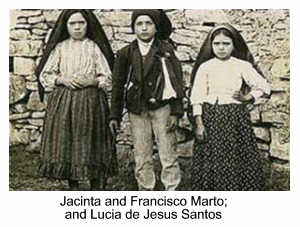 The Virgin Mary is purported to have appeared to three small children (Jacinta and Francisco Marto, and Lucia de Jesus Santos) in the village of Fátima on six occasions between May 13 and October 13, 1917. The Queen of Heaven was announced by an angel, and appeared as a woman clothed in the sun. She instructed the children in the building of a shrine in her honor that would be dedicated to healing the sick. The place became a center for Roman Catholic pilgrimage, and in 1944 a grand basilica was constructed there. Jacinta and Francisco died as children, but Lucia lived until February 13, 2005. The Virgin Mary is purported to have appeared to three small children (Jacinta and Francisco Marto, and Lucia de Jesus Santos) in the village of Fátima on six occasions between May 13 and October 13, 1917. The Queen of Heaven was announced by an angel, and appeared as a woman clothed in the sun. She instructed the children in the building of a shrine in her honor that would be dedicated to healing the sick. The place became a center for Roman Catholic pilgrimage, and in 1944 a grand basilica was constructed there. Jacinta and Francisco died as children, but Lucia lived until February 13, 2005.
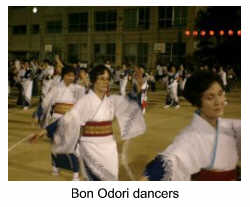 July 13 - 15 — Bon Festival July 13 - 15 — Bon Festival
Japan (Buddhist)
The Feast of the Lanterns, also called the Feast of the Dead, has been celebrated in Japan for 1,400 years. This is a time to visit gravesides in memory of the departed. Ancestors are honored for their deeds. Incense is burned and lanterns are lit to lead the dead back home, where favorite foods of the dead are prepared and eaten. The home is lit all night long with lanterns and cheery fires. Conversations with the dead are held, with family members speaking to the spirit that is present. The festival, which is a solemn event, comes to a close on July 15th with a dance called the Bon Odori.
July 14 — Bastille Day
France
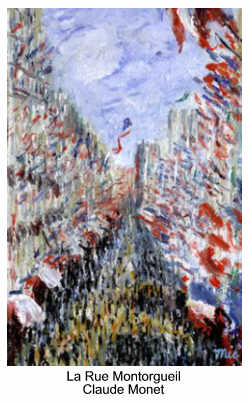 On July 14, 1789 an angry mob attacked the fortress and state prison in Paris called the Bastille. Seven inmates were released and the governor was killed. This marked the beginning of the French revolution which would overthrow oppressive aristocracy. Although a free, stable, and democratic system of government for France wasn't in place for another hundred years, Bastille Day continues to be celebrated as the first strike for democracy in that country. The streets are filled with parades, music, and dancing. Fireworks and bonfires are ignited. "Vive la France!" On July 14, 1789 an angry mob attacked the fortress and state prison in Paris called the Bastille. Seven inmates were released and the governor was killed. This marked the beginning of the French revolution which would overthrow oppressive aristocracy. Although a free, stable, and democratic system of government for France wasn't in place for another hundred years, Bastille Day continues to be celebrated as the first strike for democracy in that country. The streets are filled with parades, music, and dancing. Fireworks and bonfires are ignited. "Vive la France!"
July 17 — Amaterasu-O-Mi-Kami
Japan
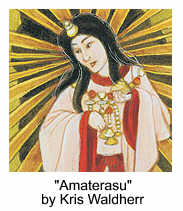 Amaterasu-O-Mi-Kami, the Great Goddess Spirit Shining in Heaven, is the Japanese Sun goddess who rules weaving and agriculture. Disgusted with her brother's violence toward women, Amaterasu hid herself away in a cave and refused to come out. Great disaster fell upon the earth. A convocation of eight hundred deities gathered outside the cave. They decided to try to lure her out with a magnificent celebration. Upon hearing the loud commentaries about an erotic dance being performed by the crone Goddess Ame No Uzume, Amaterasu could no longer contain her curiosity. She had to see what all the hoopla was about. As she was walking out of the cave, the gods reflected her brilliant light in a large mirror. The beauty of her own light enticed Amaterasu back into the world where she has remained ever since. Her image, the Rising Sun, is emblazoned on the flag of Japan. Amaterasu-O-Mi-Kami, the Great Goddess Spirit Shining in Heaven, is the Japanese Sun goddess who rules weaving and agriculture. Disgusted with her brother's violence toward women, Amaterasu hid herself away in a cave and refused to come out. Great disaster fell upon the earth. A convocation of eight hundred deities gathered outside the cave. They decided to try to lure her out with a magnificent celebration. Upon hearing the loud commentaries about an erotic dance being performed by the crone Goddess Ame No Uzume, Amaterasu could no longer contain her curiosity. She had to see what all the hoopla was about. As she was walking out of the cave, the gods reflected her brilliant light in a large mirror. The beauty of her own light enticed Amaterasu back into the world where she has remained ever since. Her image, the Rising Sun, is emblazoned on the flag of Japan.
[Image of Amaterasu © Kris Waldherr, www.artandwords.com, used by permission.]
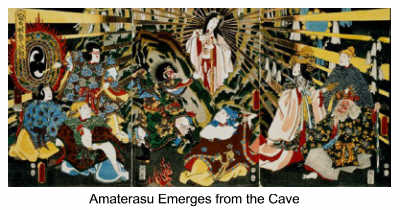
July 30 — Full Moon
The full moon closest to the Summer Solstice has many names. It is called the Buck Moon because July is normally the month when the velvety new antlers of buck deer push out of their foreheads. The frequent thunderstorms that happen in July also earned it the name of Thunder Moon. Another name for this month's Moon is the Full Hay Moon.
|
